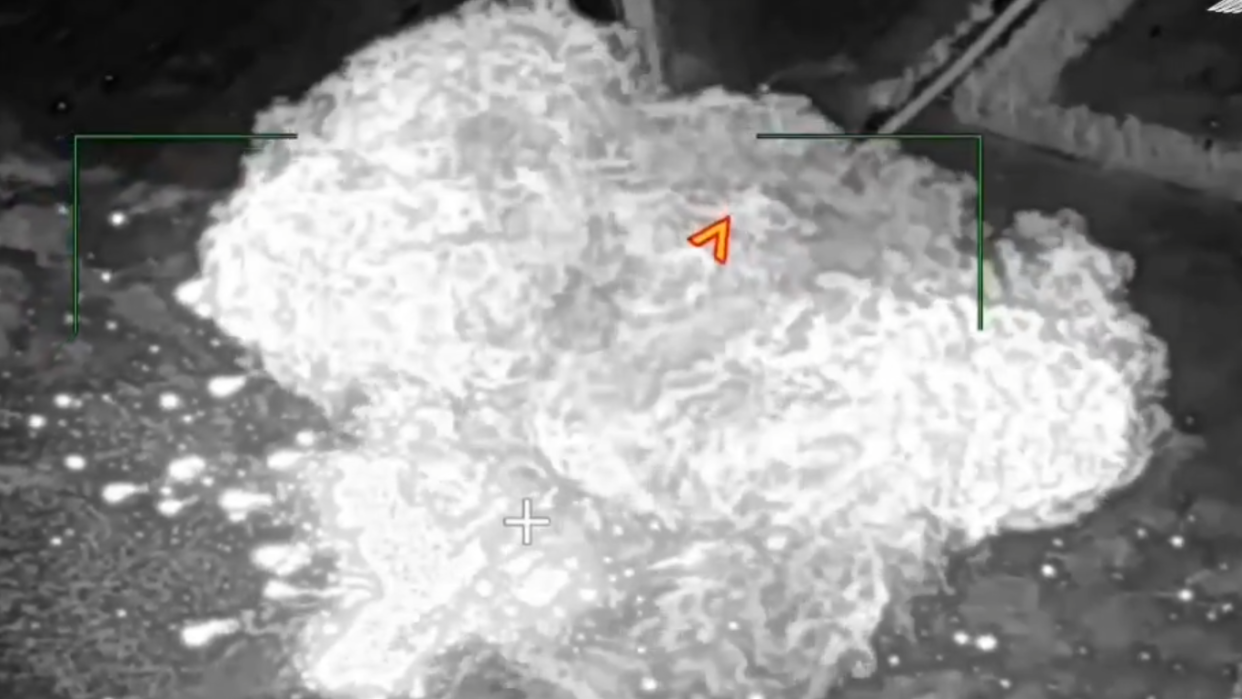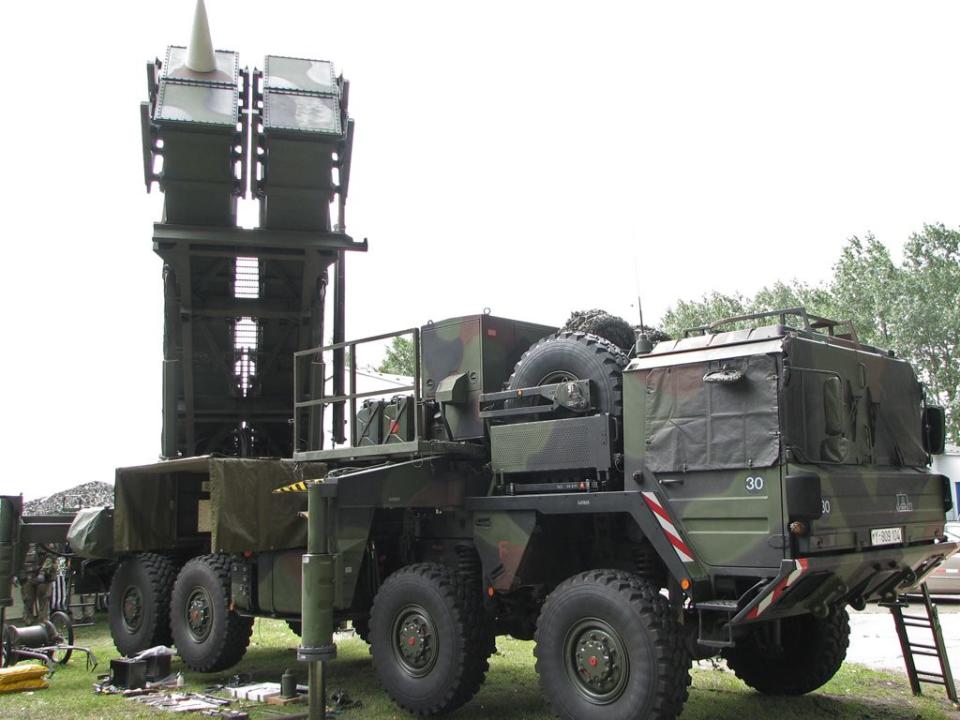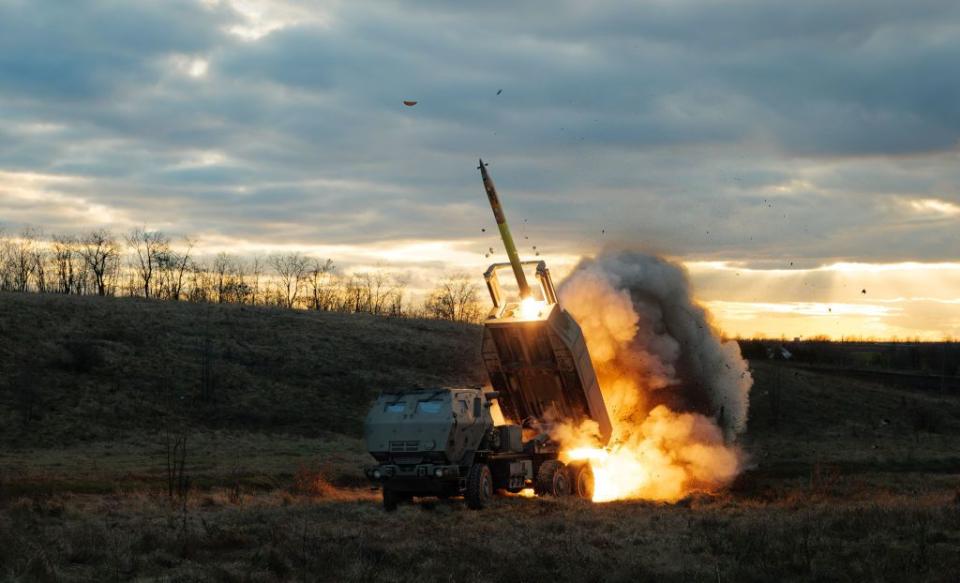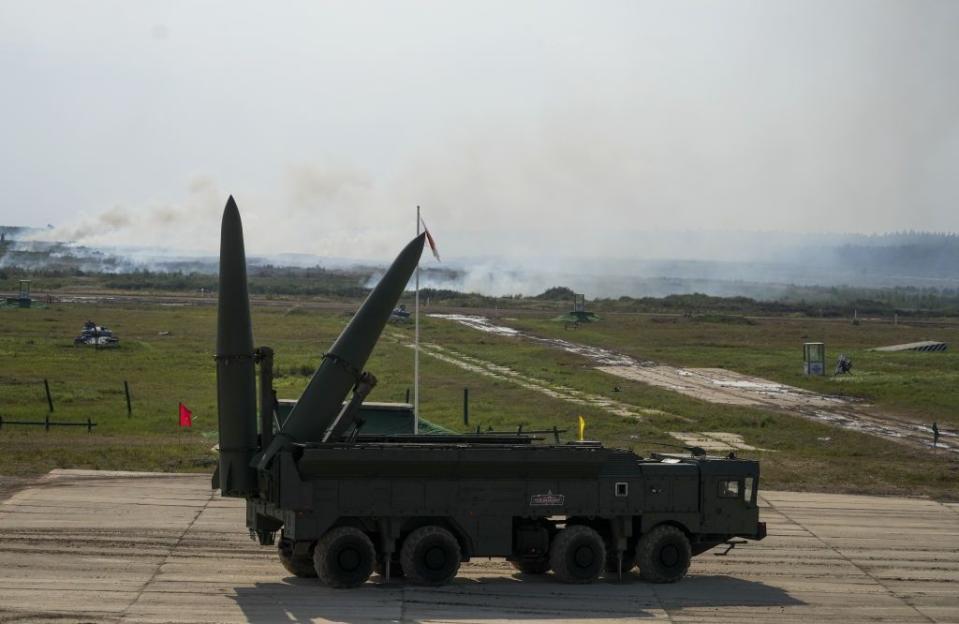Caught on Camera: A Ballistic Missile’s Wrath Wreaks Havoc

On March 9, footage made its way online from a Russian surveillance drone flying over Eastern Ukraine. The drone had its camera trained on a military convoy, which had unwisely come to a halt in the open on a road awaiting instructions on which direction to proceed. Of particular interest to the drone’s operator: two eight-wheeled trucks that appeared to be transporter-erector-launcher (TELs) designed to deliver powerful, long-range air defense missiles.
Since December of last year, Ukraine has darted long-range Patriot air defense missile launchers surprisingly close to the frontline, leveraging their maximum range of 100 miles to pick off Russian Su-34 bombers, Su-35 fighters, and even a big A-50 Mainstay radar plane in airspace ordinarily thought to be safe. Such ambushes could likely be executed by detaching one or two launchers from the battery, rather than the unit’s full strength.
Wherever these trucks were bound, they did did not make it. In the blink of the eye, a projectile—likely an Iskander tactical ballistic missile plummeting at supersonic speeds—plunged down amidst the convoy and created a massive, roiling fireball that destroyed both trucks and likely killed their operators.
Two M901 launcher vehicles of the MIM-104 Patriot air defense system of the Armed Forces of Ukraine were destroyed as a result of Russian strike with Iskander ballistic missile near Pokrovsk in Donetsk Oblast of Ukraine.
Those are the two first confirmed losses of such type of… pic.twitter.com/UaK4yFKlVd— Status-6 (Military & Conflict News) (@Archer83Able) March 9, 2024
Russian social media accounts that posted the footage originally identified the air defense launchers as being some of Ukraine’s truck-based S-300PS medium-to-long range air defense systems, inherited from the Soviet Union.
But subsequently, several pro-Russian and pro-Ukrainian sources alike concluded that one or both trucks looked more like the eight-wheeled MAN KAT1 trucks used by Patriot air defense batteries—specifically, M901 launcher trucks (which carry four PAC-2 missiles) or M903 trucks (able to carry both PAC-2 and PAC-3 missiles). Their analyses point to the configuration of the driver’s windows and a ring that maybe from the swivel platform of a missile launcher, which is visible in post-strike footage of the wreckage.
This (thanks to @klinger66 ) shows the clearly visible rotational part for the Launcher, which confirms this as a M903, and not just a MAN KAT1 Logistics Vehicle(first Vehicle in the 2nd Picture).
The 2nd Picture also confirms the Vehicles being MAN KAT1s. pic.twitter.com/OPGlw17cbG— WarVehicleTracker (@WarVehicle) March 11, 2024

Some analysts argue that these could be ordinary MAN KAT trucks used for logistical missions, or that the available imagery isn’t detailed enough for positive confirmation. Ukrainian officials have not addressed the incident either way.
If the losses are indeed M901s or M903s (still unconfirmed, but looking increasingly likely), the loss of the veteran crew and expensive defensive missiles will be keenly felt. However, each of the Ukrainian Air Force’s three Patriot batteries include 4-8 launchers, a command post, and radar vehicles. Ukraine has also received 4 spare launchers courtesy of The Netherlands and Germany. Thus, the loss of one or two TELARs wouldn’t cripple a battery, but would reduce its effectiveness.
It’s notable that the footage of this attack has appeared less then a week after a video surfaced of a similar strike targeting an M142 HIMARS rocket launcher, 25 miles back from the frontline near Nykanorivka. The attack, also likely by a ballistic missile, destroyed the HIMARS and caused the motors of one of its 227-millimeter rockets to ignite and weave crazily over the field before crashing.
After a 21 month run, a 🇺🇦 M142 HIMARS has finally been destroyed (on video).
While 2 have been damaged previously, these systems have arguably made a gigantic difference in the war against the Russian invaders. pic.twitter.com/U6Xd8dSJ5d— CJ (@CasualArtyFan) March 5, 2024
Since HIMARS entered service in the summer of 2022, it and similar M270 MLRS launchers have inflicted massive damage to Russian units using GPS-guided GMLRS precision rockets and (starting in late 2023) ATACMS ballistic missiles. The debut of GMLRS strikes in the summer of 2022 brought Russia’s offensive to a screeching halt, while the first ATACMS strike in fall of 2023 destroyed or damaged two-dozen landed Russian helicopters.
While Russia’s defense ministry has previously claimed to have destroyed more HIMARS than had ever been delivered to Ukraine, it was never able to provide images confirming even a single loss—though at least two battle-damaged M142s were known to have been shipped back to the U.S. in February for repairs.

Ultimately, in such a large-scale war, any system employed extensively is bound to suffer losses. These systems depend on leveraging distance, concealment, and mobility to avoid direct attacks. In the case of both losses, the systems were exposed to aerial surveillance in the open while immobile for too long.
Though the losses of these valuable system are painful, they fall short of seriously denting Ukraine’s military capabilities by themselves. After all, Ukraine has received a total of 39 HIMARS launchers, as well as 23 M270 tracked launchers (carrying twice the number of rockets as HIMARS).
What could be much more problematic is if Russia can sustain this streak of time-sensitive deep strikes. Given the seemingly similar methods used in both attack, the answer to that question risks being ‘yes’—unless Ukraine can adopt new tactics to mitigate Russia’s techniques.
An improved Russian reconnaissance-strike complex?
Up until now, Russian warplanes and missiles have not been very successful at hitting mobile targets at operational depth—such as supply and reinforcement convoys, mobile artillery, and air defense systems. And many of the strikes that have been attempted have destroyed elaborate Ukrainian decoys. The lack of effective strikes is a major shortcoming, as these are traditionally the most lucrative targets for aerial interdiction.
Russia did devote substantial attention to targeting Patriot air defense batteries shortly after they arrived in theater in the spring of 2023. But these systems (when deployed) can defend themselves capably against missiles, and a Russian hypersonic missile barrage succeeded only in partially damaging one unit, which was soon repaired.
The two strikes in March of 2024 may reflect that Russia got lucky, catching mobile targets during extended periods of immobility and non-concealment. But, perhaps, it shows that Russia has improved its reconnaissance-strike complex.
“It could be either,” Samuel Bendett, an expert on Russian military drone and AI technology, wrote to PopMech. “My preliminary take is that such strikes on highly-prized Ukrainian systems are part of Russia’s evolving recon force/strike contour.”
The attacks appear to show that Russian surveillance drones infiltrated deeper over Ukrainian-controlled territory, rapidly transmitting target cuing to the Iskander-M ballistic missiles systems that were potentially deployed a few hundred miles away.

An Iskander-M launcher truck carries two 9M723 missiles that achieve a peak velocity approaching 6 times the speed of sound—or 1.25 miles per second. That improves the odds of reaching a time-sensitive target before it moves.
And when using an image-matching optical seeker (with the target image supplied by the drone), a 9M723 can land within 5-7 meters of target on average, precise enough to destroy any nearby vehicles with the weapon’s half or three-quarter ton warhead. Only a limited subset of Ukraine’s air defense are effective against ballistic missile threats—notably including Patriot and Soviet S-300V systems.
There are a few alternatives to Iskander that should be considered based on the video evidence of a precise strike with a very large blast. Those include the Tornado-S system (derived from the big BM-30 rocket-launching truck), which can launch 300-millimeter 9M542, 9M544, and 9M549 satellite-guided rockets (with ranges of 75 miles). The 9M542 rocket carries a 30-pound fragmentation warhead, while the other two variants dispense 552 and 72 cluster bomblets, respectively. In theory, operating as a sort of ‘Russian HIMARS’, they land (on average) within 7-15 meters of target when using satellite navigation.
Photos of a Russian Tornado-S MLRS 9M544 precision-guided munition in the Dnipropetrovsk area.https://t.co/4PBnJH1uFn pic.twitter.com/JYPH4LViFu
— Rob Lee (@RALee85) April 9, 2022
There are also reports that Russia has begun fielding (and possibly mass-producing) a new UMPB D30SN precision glide bomb—a ‘universal’ system launchable either from aircraft or by BM-30 Smerch multiple rocket launcher trucks. Powered by a jet engine, this 300-millimeter-diameter weapon sports folding wings and pop-out maneuvering fins. It carries a 551-pound warhead, eight antennas for its Kometa satellite navigation system, and an inertial navigation unit.
Supposedly, these may have greater accuracy than the UMPK bombs that Russia has employed with mixed results in Ukraine, and nearly twice the range (at an estimated 49-56 miles).
The Fighterbomber TG channel posted a photo showing what this munition reportedly looks like. Per the post, this an UMPB D-30SN. The UMPB reportedly stands for "Universal Interspecific Glide Munition/Bomb". The "D-30" denotes that its diameter is 30cm.https://t.co/LwH1zdEhm0 https://t.co/4B8238a5Tv pic.twitter.com/0C3ODZC1jB
— Guy Plopsky (@GuyPlopsky) March 9, 2024
Russia has arguably never lacked for strike weapons, but has been more impeded by organizational and doctrinal issues—with the artillery arm often taking too long to respond to fire support requests outside of its immediate chain of command verticals—and expending munitions wastefully. By 2023, reforms to the reconnaissance-strike circuit were already evident, focusing on brigade-level operations and more precise drone-directed precision fires.
Perhaps the latest strikes reflect further organizational innovation that connects Russia’s drone reconnaissance units to Iskander launchers on standby, extending the ‘hunter-killer’ spotter-shooter kill chain even deeper over Ukrainian airspace.
Just as Russia belatedly acted to curb the effectiveness of HIMARS late in 2022 by moving logistical depots further back and more systematic deployment of air defenses, Ukraine must take into account the recent Russian deep strikes, and formulate countermeasures to mitigate the risks of deeper Russian strikes going forward.
That might involve the more cautious use of HIMARS, Patriot, and similar systems. Or, it could mean adhering to more rigorous standard operating procedures for concealment further behind the frontline, and deployment of additional air defenses and mobile or local satellite-jamming or spoofing capabilities.
You Might Also Like


